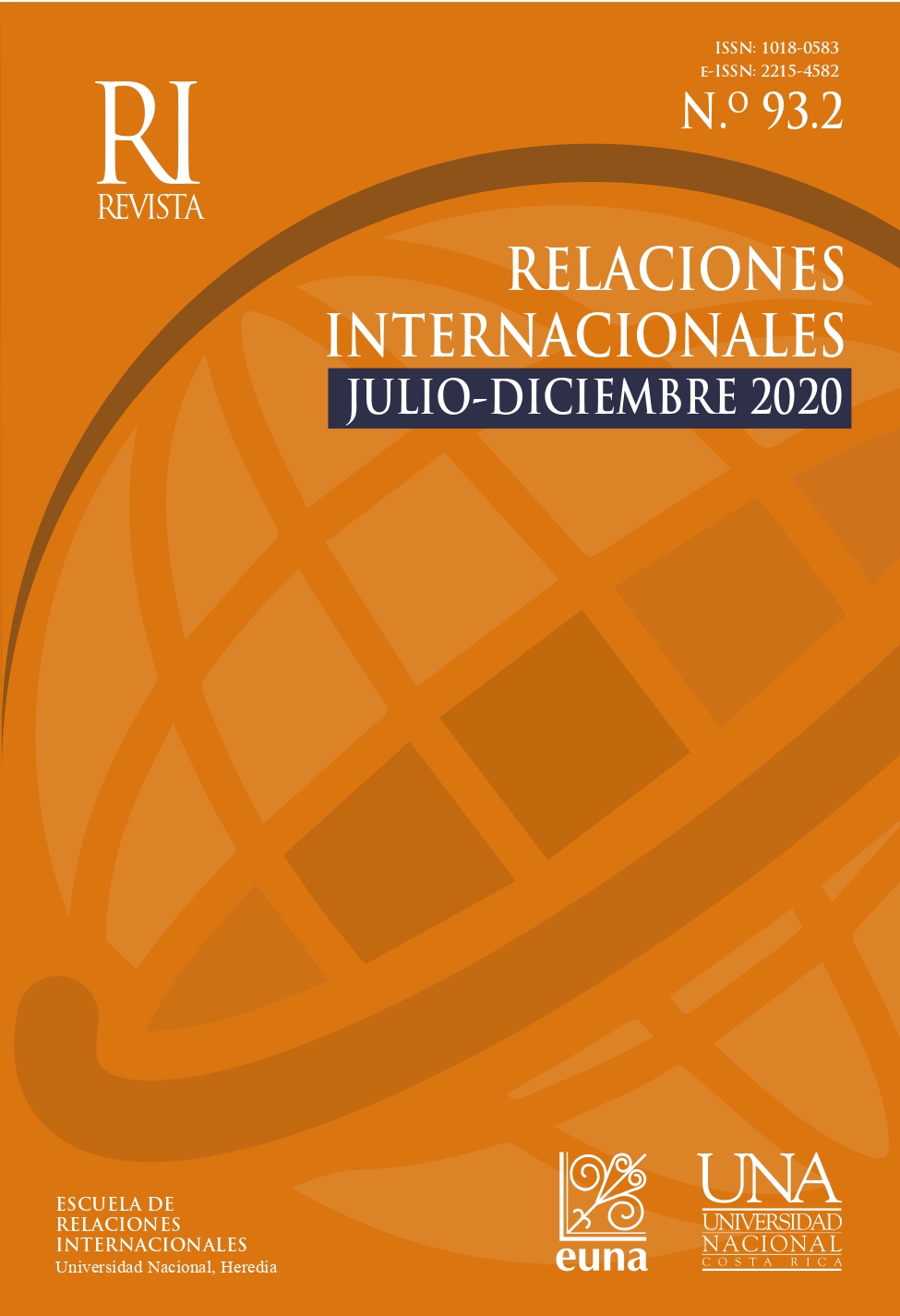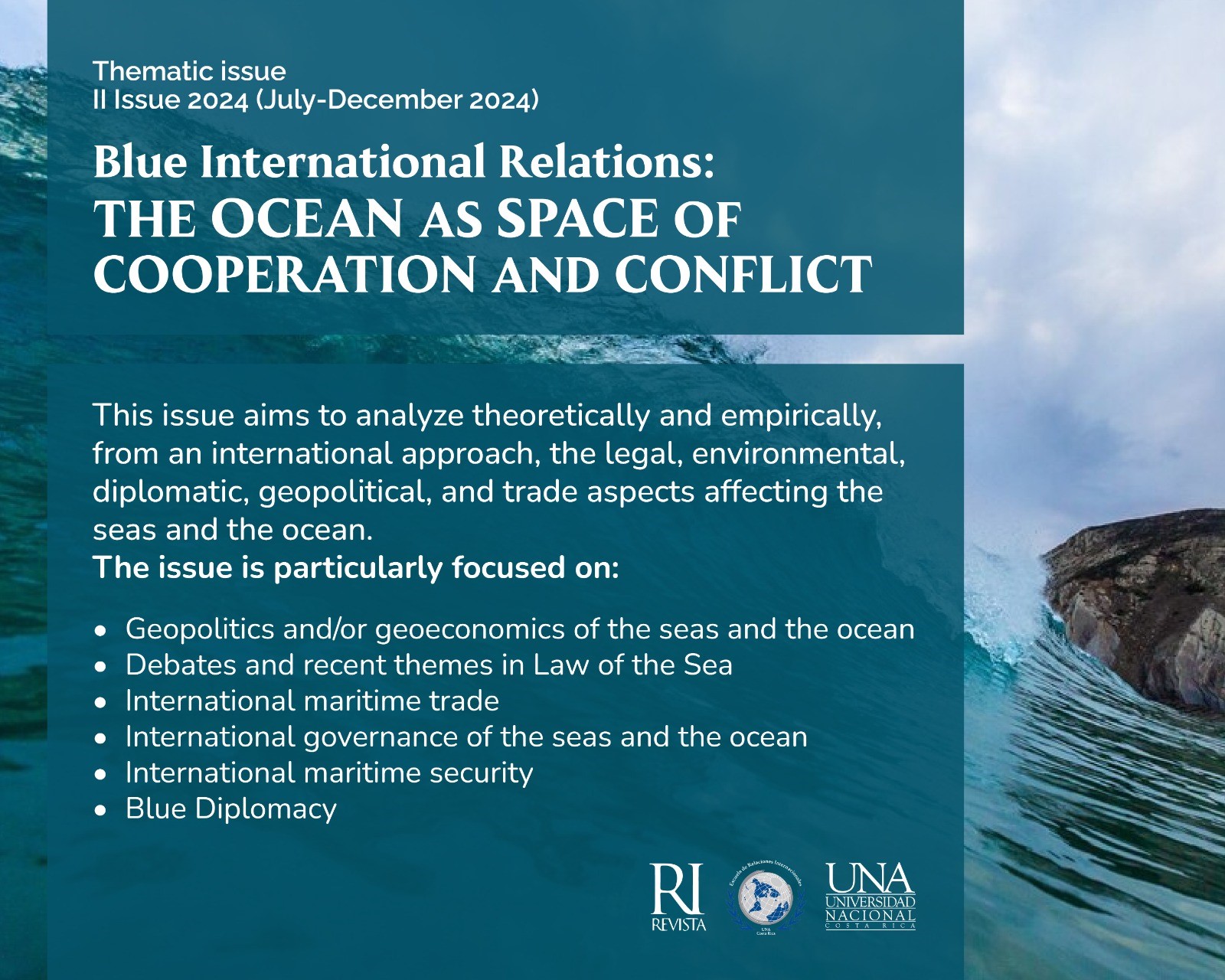The Projection of the Belt and Road Initiative into the European Union (2014-2019): Economic and Normative Implications
DOI:
https://doi.org/10.15359/ri.93-2.1Keywords:
Belt and Road Initiative, China-European Union strategic partnership, Economic Cooperation, Foreign Investment, AsymmetriesAbstract
This research analyzes the characteristics of the projects of the Belt and Road Initiative (BRI) implemented during the period 2014-2019 in the European Union (EU), and their relevance for the development of Sino-European political and economic relations. This process has been developed in a context of increasing economic interdependence between the actors, something evidenced by the high volumes reached in their commercial exchanges. The research uses an approach based on the liberal-institutionalism theory in order to analyze the preferences chosen by China and the EU to guide their relationship in a pragmatic way, although not without asymmetries, as well as the institutional instruments used to coordinate the bilateral agenda: the institutional platform having the coordinating function of the BRI activities in the EU is the China-EU strategic partnership. Some of the conclusions identified in the research are: 1) the EU is considered by the Chinese government as a fundamental region for the implementation of the BRI; 2) the investing in infrastructure projects financed by Chinese capital has the objective of deepening economic interdependence with EU members, and 3) the Chinese government must take into account the economic interests of the European part and respect for EU regulations.
References
Brown, K. (2012). China’s Overseas Investment in the European Union. The International Spectator, 47(2), 74-86.
Casarini, N. (2015). China’s Rebalancing towards Europe. The International Spectator, 50(3), 122-129.
China File. (18 de octubre, 2019). The Future of Huawei in Europe (A China File Conversation). http://www.chinafile.com/conversation/future-of-huawei-europe
Comisión Europea y Alto Representante de la UE para la Política Exterior y Asuntos de Seguridad. European Commission and HR/VP Contribution to the European Council. EU-China (2019). A Strategic Outlook (JOIN 5 final). https://ec.europa.eu/commission/sites/beta-political/files/communication-eu-china-a-strategic-outlook.pdf
Comisión Europea. (2017a). Joint statement by the President of the European Commission, Jean-Claude Juncker, and the President of the European Council, Donald Tusk on the Passing Away of Liu Xiaobo. http://europa.eu/rapid/press-release_STATEMENT-17-2032_en.htm.
Comisión Europea. (2017b). Speech by President Jean-Claude Juncker at the 12th EU-China Business Summit. http://europa.eu/rapid/press-release_SPEECH-17-1526_en.htm.
Comisión Europea. (2016a). 18th EU-China Summit in Beijing (Announcement). http://www.europa.eu/rapid/press-release_AC-16-3700_en.pdf.
Comisión Europea. (2016b). Comunicación de la Comisión al Consejo Europeo y al Parlamento Europeo. Hacia una política comercial sólida para la Unión Europea, en beneficio del empleo y el crecimiento (COM 690 final). http://ec.europa.eu/transparency/regdoc/rep/1/2016/ES/COM-2016-690-F1-ES-MAIN.PDF
Comisión Europea. (2016c). EU and China agree on scope of the Future Investment Deal. http://trade.ec.europa.eu/doclib/press/index.cfm?id=1435.
Comisión Europea. (2015). Investment Plan for Europe goes global: China announces its contribution to #investEU. http://europa.eu/rapid/press-release_IP-15-5723_es.htm
Comisión Europea. (2006). EU – China: Closer partners, growing responsibilities (COM 631 final). http://eurlex.europa.eu/LexUriServ/LexUriServ.do?uri=COM:2006:0631:FIN:EN:PDF
Comisión Europea. (2003). Hacia una asociación madura. Intereses comunes y desafíos en las relaciones UE-China (COM 533 final). http://eur-lex.europa.eu/legalcontent/ES/TXT/PDF/?uri=CELEX:52003DC0533yfrom=ES
Comisión Europea y Alto Representante de la Unión para Asuntos Exteriores y Política de Seguridad. (2016). Comunicación conjunta al Parlamento Europeo y al Consejo: Componentes de una nueva estrategia de la UE respecto a China. http://eur-lex.europa.eu/legal-content/ES/TXT/?uri=LEGISSUM:r14206
Comisión Nacional para el Desarrollo y la Reforma, Ministerio de Asuntos Exteriores y Ministerio de Comercio de China. (2015). Vision and Actions on Jointly Building Silk Road Economic Belt and 21st-Century Maritime Silk Road. http://en.ndrc.gov.cn/newsrelease/201503/t20150330_669367.html
Consejo de Estado de China. (2018). China’s Arctic Policy. http://english.gov.cn/archive/white_paper/2018/01/26/content_281476026660336.htm
Consejo Europeo. (2009). 11th EU-China Summit Joint Press Communiqué. http://www.consilium.europa.eu/uedocs/cms_data/docs/pressdata/en/er/107965.pdf
Consejo Europeo. (9, detiembre, 2006). Ninth EU-China Summit Helsinki. Joint Statement 12642/06 (Presse 249). http://www.consilium.europa.eu/ueDocs/cms_Data/docs/pressData/en/er/90951.pdf
Dadush, U., Domínguez-Jiménez, M., y Gao, T. (2019). The State of China-European Union Economic Relations. Working Paper 9, Bruegel, 1-26. https://www.bruegel.org/wp-content/uploads/2019/11/WP-2019-09-China-final.pdf
Díaz Barrado, C. (2016). La Unión Económica Euroasiática: Un paso crucial para la integración en el continente europeo y en el espacio euroasiático. Revista General de Derecho Europeo, 40. https://www.iustel.com/v2/revistas/detalle_revista.asp?id_noticia=417866&d=1
Dirección General de Comercio de la Comisión Europea. (2018) European Union, Trade in Goods whit China. Bruselas.
Dokos, T. (2012). Who Lost Greece? The Geopolitical Consequences of the Greek Crisis. Policy Paper, 18, 1-23.
Esteban, M. y Li Y. (2017). Demystifying the Belt and Road Initiative: Scope, Actors and Repercussion for Europe. Duisburger Arbeitspapiere Ostasienwissenschaften 117/2017 (pp. 1-24). University of Duisburg-Essen, Institute of East Asian Studies.
Eurostat. (2020) China-European Union Trade 2012-2018. Bruselas (actualizado al 16 de julio).
Fallon, T. (8 de noviembre, 2019). Germany’s Faustian Bargain with China. The Diplomat, https://thediplomat.com/2019/11/germanys-faustian-bargain-with-china/
Feng, Z. (2008). A Chinese Perspective on China-European Relations. En G. Grevi y A. de Vasconcelos (Eds.), Partnerships for Effective Multilateralism, Chaillot Paper 109. European Union Institute for Security Studies.
Ghiasy, R. y Zhou J. (2017). The Silk Road Economic Belt: Considering Security Implications and EU–China Cooperation Prospects. SIPRI-Friedrich Ebert Stiftung, i-60.
Governo della Repubblica Italiana. (12 de marzo, 2019). Via della Seta, il testo dell’intesa tra l’Italia e la Cina: La versione inglese e la traduzione in italiano. Corriere della Sera. Roma.
Gonçalves, A. (2017). China’s ‘One Belt, One Road’ Initiative. Just Economics?. Pyrex Journal of Political Science And International Relations, 3(2), 13-29.
Holslag, J. (2017). How China’s New Silk Road Threatens European Trade. The International Spectator, 52(1), 46-60.
Hong, Z. (2017). An Overview of the China-EU Strategic Partnership (2003–2013). En Z. Hong (Ed.), China-EU Relations: Reassessing the China-EU Comprehensive Strategic Partnership (pp. 3-31). Social Sciences Academic Press y Springer.
Huliaras, A. y Petropoulos S. (2014). Shipowners, Ports and Diplomats: the Political Economy of Greece’s Relations with China. Asia Europe Journal, 12(3), 215-230.
Jones, D. A. y Liu, H. (2017). Management of Chinese Foreign Direct Investment: “One Belt, One Road” Across Eurasia to Africa and Europe Amidst Maritime Tensions in the South China Sea Region. International Relations and Diplomacy, 5(8), 486-500.
Juncker, J-C. (2015). The EU and China: A Solid Partnership - Speech by President Juncker at the EU-China Business Summit. http://europa.eu/rapid/press-release_SPEECH-15-5278_en.htm.
Kaplan, Y. (2017). China’s OBOR as a Geo-Functional Institutionalist Project. Baltic Journal of European Studies, 7(1), 7-23.
Kavalski, E. (2013), The Struggle for Recognition of Normative Powers: Normative power Europe and normative power China in Context. Cooperation and Conflict, 48(2), 247-267.
Keohane, R. y Nye, J. (2005). La interdependencia en la política mundial. En A. Borja (Ed.), Ensayos escogidos de Robert O. Keohane (pp. 91-124). Centro de Información y Docencia Económica.
Keohane, R. y Nye, J. (1988). La interdependencia en la política mundial. En R.O. Keohane y J. S. Nye (Ed.), Poder e interdependencia: La política mundial en transición (pp. 15-38). Grupo Editor Latinoamericano.
Le Corre, P. Pollack, J. (2017). China’s rise: what about a Transatlantic Dialog? Asia-Europe Journal, 15(2), 147-160.
Liu, X. (26, enero, 2018). China proposes ‘Polar Silk Road’ cooperation in Arctic region. Global Times. http://www.globaltimes.cn/content/1086740.shtml
Li, M. (2016). China-EU Relations: Rivalry Impedes Strategic Partnership. En J. Wang y W. Song (Eds.), China, the European Union, and the International Politics of Global Governance (pp.13-28). Palgrave-Macmillan.
Malmström, C. (2015). Modernising Trade Policy - Effectiveness and Responsibility. http://trade.ec.europa.eu/doclib/docs/2015/july/tradoc_153621.pdf.
Manners, I. (2009). The Concept of Normative Power in World Politics. DIIS Brief. Danish Institute for International Studies, 1-5.
Parlamento Europeo. (Abril, 2019). Towards a New EU Policy approach to China, 21st EU-China Summit. –https://www.europarl.europa.eu/RegData/etudes/ATAG/2019/637913/EPRS_ATA(2019)637913_EN.pdf
Pomfret, R. (2018). The Eurasian Land Bridge. The Role of Service Providers in Linking the Regional Value Chains in East Asia and the European Union. ERIA Discussion Paper Series 2018-01, 1-19). Economic Research Institute for ASEAN and East Asia.
Psaropoulos, J. (2019). Greece and China hail Strategic Partnership, as US and EU look on. Al Jazeera News, Atenas, 11 de noviembre. https://www.aljazeera.com/news/2019/11/greece-china-hail-strategic-partnership-eu-191111170150762.html
Rémond, M. (2007). The EU’s Refusal to grant China “Market Economy Status” (MES). Asia Europe Journal, 5(3), 345-356.
Reuter, E. (2007). China–EU: A New Agenda. Asia Europe Journal, 5(2), 171-179.
Richet, X. (2018). The 16+1 Format: Chinese presence in Fragmented Markets on the Periphery of Europe. Working Paper, 21, 1-16. China-CEE Institute.
Richet, X., Ruet J., y Wang X. (2017). New Belts and Roads: Redrawing EU-China Relations. En A. Amighini (Ed.), China’s Belt and Road: a Game Changer (pp. 97-119). Edizioni Epoké – ISPI.
Reuters. (2016). Piraeus Port shareholders approve COSCO Concession Deal. Reuters, 10 de junio. http://www.reuters.com/article/us-eurozone-greece-privatisation-protest-idUSKCN0YW0ON
Rocha Pino, M. J. (2018). La asociación estratégica China-Unión Europea durante el periodo 2010-2018: Interdependencia económica y tensiones normativas. Revista Electrónica de Estudios Internacionales, 36, 1-28. http://www.reei.org/index.php/revista/num36
Scott, D. (2009). From Brussels to Beijing: Comparing the Regionalization Strategies of the EU and China. En E. Kavalski (Ed.), China and the Global Politics of Regionalization (pp. 109-119). Ashgate.
Servicio Europeo de Acción Exterior. (2016). Una visión común, una actuación conjunta: Una Europa más fuerte. Estrategia global para la política exterior y de seguridad de la Unión Europea. https://europa.eu/globalstrategy/sites/globalstrategy/files/eugs_es_version.pdf.
Servicio Europeo de Acción Exterior y Ministerio de Asuntos Exteriores de China. (2013). EU–China 2020 Strategic Agenda for Cooperation. http://eeas.europa.eu/china/docs/20131123_agenda_2020__en.pdf.
Statistisches Bundesamt. (2018). Ranking of Germany’s Trading Partners in Foreign Trade. https://www.destatis.de/EN/FactsFigures/NationalEconomyEnvironment/ForeignTrade/Tables/OrderRankGermanyTradingPartners.pdf?__blob=publicationFile
Steinbuka, I., Muravska T., y Kuznieks A. (2017). Cooperation Formats of China and Europe: Synergies and Divergences. Baltic Journal of European Studies, 7(1), 97-117.
Xi, J. (2017). Xi Jinping’s keynote speech at the World Economic Forum. http://www.china.org.cn/node_7247529/content_40569136.htm
Xi, J. (2013). President Xi Jinping delivers Important Speech and Proposes to build a Silk Road Economic Belt with Central Asian Countries. http://www.fmprc.gov.cn/mfa_eng/topics_665678/xjpfwzysiesgjtfhshzzfh_665686/t1076334.shtml.
Published
How to Cite
Issue
Section
License

Revista de Relaciones Internacionales por Universidad Nacional de Costa Rica está bajo una Licencia Creative Commons Atribución-NoComercial-SinDerivar 4.0 Internacional








1.png)







3.png)
